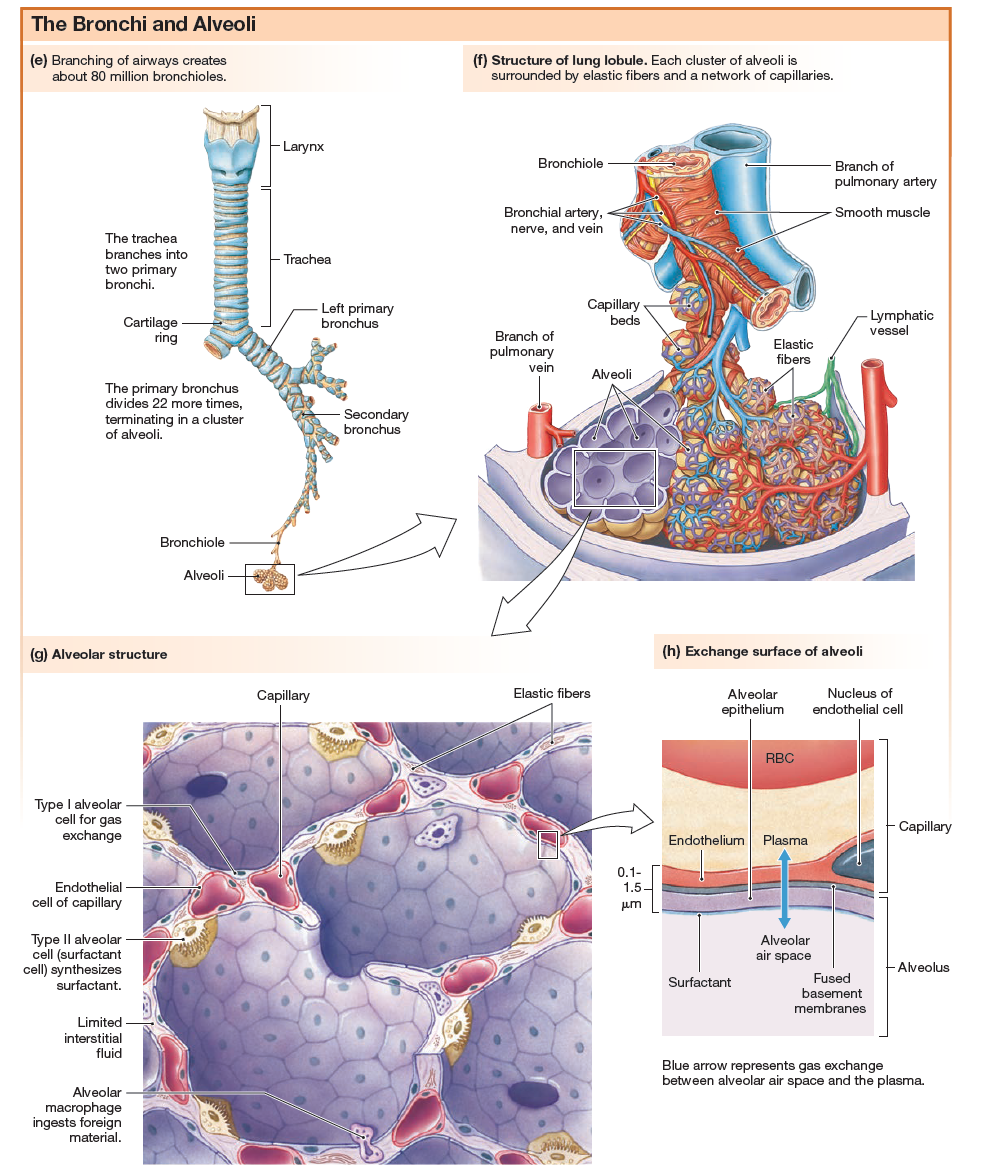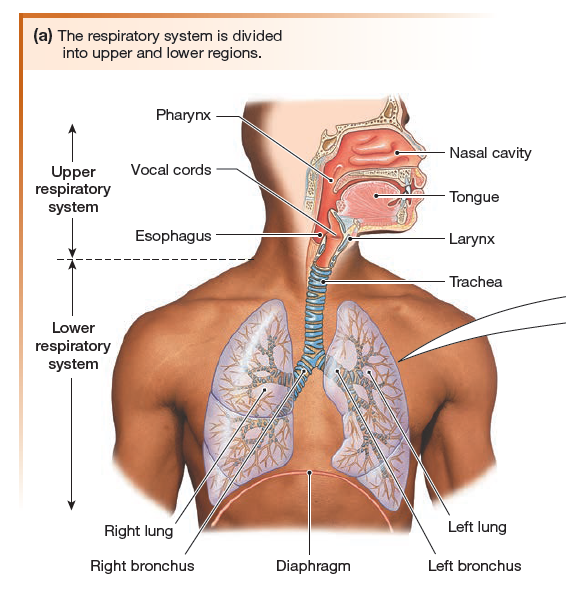Bio307 - Test #3 - Chapter 17 (Mechanics of Breathing)
0.0(0)
Card Sorting
1/29
Earn XP
Description and Tags
Study Analytics
Name | Mastery | Learn | Test | Matching | Spaced |
|---|
No study sessions yet.
30 Terms
1
New cards
Ventilation
movement of air into and out of the lungs
2
New cards
Inspiration
Movement of air into the lungs: Alveolar pressure decreases, air flows into the lungs. Requires the contraction of inspiratory muscles and the diaphragm.
3
New cards
Expiration
The movement of air out of the lungs, usually passive, results from elastic recoil of the lungs
4
New cards
Alveoli
series of interconnected sacs, and associated pulmonary capillaries. Form the exchange surface, where oxygen moves from inhaled air to the blood, and carbon dioxide moves from the blood to air that is about to be exhaled.
5
New cards
Diaphragm
a muscular partition separating the abdominal and thoracic cavities; functions in respiration
6
New cards
Pleura
the thin serous membrane around the lungs and inner walls of the chest
7
New cards
Surfactant
decreases surface tension in the fluid lining the alveoli. Reduced surface tension prevents smaller alveoli from collapsing and makes it easier to inflate the lungs.
8
New cards
Partial Pressure
pressure contributed by a single gas in a mixture
9
New cards
Tidal Volume
amount of air taken in during a single normal inspiration
10
New cards
Inspiratory reserve volume
additional volume inspired above the tidal volume
11
New cards
expiratory reserve volume
amount of air forcefully exhaled at the end of a normal expiration
12
New cards
residual volume
amount of air in the respiratory system after maximal exhalation
13
New cards
total lung capacity
composed of vital capacity (sum of inspiratory reserve volume, expiratory reserve volume, tidal volume) and the residual volume
14
New cards
vital capacity
sum of inspiratory reserve volume, expiratory reserve volume, tidal volume
15
New cards
bronchoconstriction
increases resistance to blood flow, decreases amount of fresh air reaching the alveoli, occurs in response to irritant stimulation
16
New cards
bronchodilation
increased CO2 in expired air relaxes bronchiolar smooth muscle, result of presence of epinephrine causes dilation
17
New cards
total pulmonary ventilation
volume of air moved into and out of the lungs each minute

18
New cards
COPD (chronic obstructive pulmonary diseases)
chronic disease of the lungs, where bronchioles can collapse/close off before a forced expiration is completed, where constriction of airways and difficulty in breathing can occur
ex: emphysema, chronic bronchitis
ex: emphysema, chronic bronchitis
19
New cards
Why we need Oxygen
O2 is necessary for aerobic cellular respiration, for production of ATP from glucose
When CO2 is present, it affects the ability of hemoglobin to bind oxygen, as CO2 is an allosteric inhibitor to O2 binding hemoglobin
When CO2 is present, it affects the ability of hemoglobin to bind oxygen, as CO2 is an allosteric inhibitor to O2 binding hemoglobin
20
New cards
Order of Air Passage into Lungs
Nasal Cavity -> Pharynx -> Larynx -> Trachea -> Primary Bronchi -> Secondary Bronchus -> Bronchiole -> Alveoli -> Pulmonary Capillaries adjacent to the Alveoli

21
New cards
Label 17.2a

22
New cards
Label 17.2e

23
New cards
How do Upper Airways Condition Air
- Temperature Control (Warming air)
- Humidify (Adding water vapor until air reaches 100% humidity, so moist exchange epithelium does not dry out)
- Filters out Foreign Material (so that viruses, bacteria, and inorganic particles do not reach alveoli)
- Humidify (Adding water vapor until air reaches 100% humidity, so moist exchange epithelium does not dry out)
- Filters out Foreign Material (so that viruses, bacteria, and inorganic particles do not reach alveoli)
24
New cards
Partial Pressure Gradients
Gases always flow down their own partial-pressure gradients
25
New cards
Cause of Airflow into Lung
1) Diaphragm contracts
2) Causes lower air pressure in the thoracic cavity relative to outside of the body
2) Air moves from outside the body to lungs
3) Volume of Thoracic Cavity increases
2) Causes lower air pressure in the thoracic cavity relative to outside of the body
2) Air moves from outside the body to lungs
3) Volume of Thoracic Cavity increases
26
New cards
What causes air to move into the lungs (Inspiration)
Pressure Decrease in Thoracic Cavity (due to higher volume)
27
New cards
What causes Expiration of Air
Pressure Increase in Thoracic Cavity (due to lower volume)
28
New cards
Respiratory Volumes
Ex: What is used for B-Day Cake:
Ans: Vital Capacity (Inspiratory Capacity [ Inspiratory Reserve Volume + Tidal Volume]) + Expiratory Reserve Volume
Ans: Vital Capacity (Inspiratory Capacity [ Inspiratory Reserve Volume + Tidal Volume]) + Expiratory Reserve Volume
![Ex: What is used for B-Day Cake:
Ans: Vital Capacity (Inspiratory Capacity [ Inspiratory Reserve Volume + Tidal Volume]) + Expiratory Reserve Volume](https://knowt-user-attachments.s3.amazonaws.com/ceaab1a3a93d49b3b0571348e82cd30e.jpeg)
29
New cards
Bronchoconstriction/Bronchodilation Effect on Tidal Volume:
Bronchoconstriction increases resistance to air flow and decreases the amount of fresh air reaching the alveoli
Bronchodilation: increased CO2 in expired air relaxes bronchiolar smooth muscle, causes bronchodilation
Bronchodilation: increased CO2 in expired air relaxes bronchiolar smooth muscle, causes bronchodilation
30
New cards
Factors for Bronchi Dilation
Histamine Presence: causes bronchial constriction
Parasympathetic causes Bronchoconstriction
Stimulation of Beta-2 Receptors: bronchodilation
Parasympathetic causes Bronchoconstriction
Stimulation of Beta-2 Receptors: bronchodilation